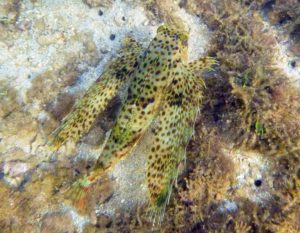
January 8, 2021
My year started out right with two recent sightings of one of the most breathtaking fish in Hawaii waters: the flying gurnard. This fish walks rather than swims, and although its fancy fins look like wings, gurnards can’t fly. They can, however, snort.
The gurnard body is narrow, but its folding side fins open so wide that when spread, the fish looks nearly round, and therefore, appears larger than it really is. In addition, a dark spot atop each fin on juveniles resembles a pair of eyes, a ploy that may intimidate potential predators.
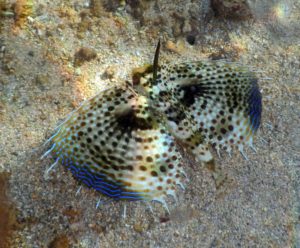
In addition to spreading its fins when threatened, the gurnard also raises a spine from its head, presumably to look intimidating. ©Susan Scott
In spite of showy fins that imply flight, the fish spends its life on the ocean floor, walking on pokey projections extending from a pair of belly fins. As it walks, the flying gurnard digs up the ocean floor with its pseudo-toenails. At the same time, the foraging fish digs with a pair of spiny claws connected to the front of the winglike fins. Such excavating uncovers the flying gurnard’s food of shrimp and crabs.
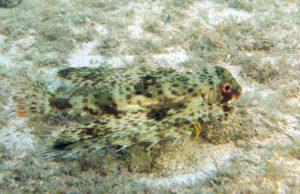
This pictures shows the clawlike spines at the front of the side fin, as well as the spiky “toes” below that the fish uses to walk and dig. ©Susan Scott
While foraging, and at rest, the fish folds the side fins, matching its background so well that snorkelers often don’t notice the remarkable fish below.
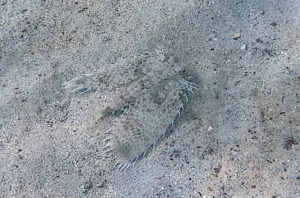
This flying gurnard off the Colony Surf Hotel, Waikiki, is barely visible. Photo courtesy Les Matsuura, sent by reader, Noriko. Check out the video from another reader, Josie, of the gurnard she found in Hawaii (specific location not mentioned.) Love the happy shaka near the end. https://youtu.be/vUzNER7_TZY
The world’s tropical waters host 7 gurnard species: 1 in the Atlantic, Caribbean and Mediterranean; 6 in the Indian and Pacific Oceans. Hawaii’s only species grows to about 12 inches long.
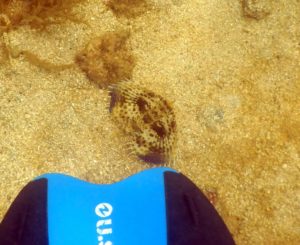
This baby gurnard was just a few inches long. I didn’t see it until my swim fin startled it into displaying. ©Susan Scott
Although scorpionfish are gurnards’ distant relatives, gurnards bear no toxins. Even so, a poke from a fin tip’s sharp spines would be painful. Best keep hands off these fish.
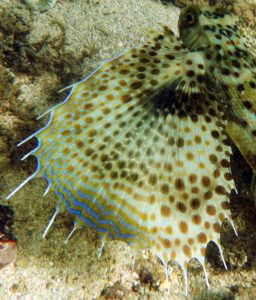
The spines on gurnard fins are sharp but have no toxin. ©Susan Scott
This is easy when the fish is alive, because it’s nearly impossible to grab a healthy flying gurnard in the water. When alarmed, the fish spreads its wings and twirls in circles, but when my camera and I get too close, the gurnards skitter away faster than I can swim.
In Hawaii, flying gurnards occasionally wash ashore in numbers that cause concerned people to report the events to DLNR. Two such strandings occurred on the south and west shores of Oahu in 2004 and 2014, both in July.
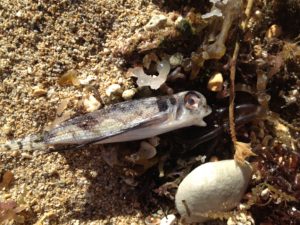
A beached flying gurnard in Waikiki, 2014. https://bit.ly/2L6t4Yt Hawaii DLNR.
Researchers found no disease in the beached fish, and the live ones in adjacent waters looked and behaved normally. The consensus was that Hawaii’s flying gurnards had exceptionally good reproductive and survival rates those summers, and simply got too close to the shore breaks while foraging.
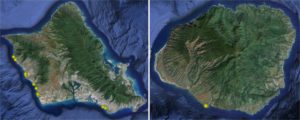
Flying gurnard stranding locations in 2014. Hawaii DLNR
Most of us call this fish a flying gurnard, but some sources prefer helmet gurnard, because bony armor encases its head, and the fish doesn’t fly. Local fish-guide author, John Hoover, calls Hawaii’s species the “oriental flying gurnard,” after its scientific name Dactyloptena orientalis. Hawaiians named it loloa’u or pinao. (Pinao also means dragonfly)
The gurnard term comes from old French, grondir, meaning to grunt. When alarmed, the bottom-dwelling fish makes a kind of growl, perhaps another tactic to scare away a predator.
I haven’t come across these fantastic fish since last summer, but because two thoughtful readers sent me flying gurnard emails, I focused the last three days on writing this post. Thank you, Noriko and Josie, for sharing your joy, and reminding me how lucky I am to live in Hawaii. After this week’s heartbreaking events, I needed that.
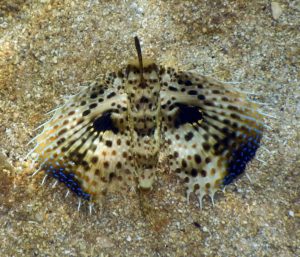
One of nature’s works of art. ©Susan Scott